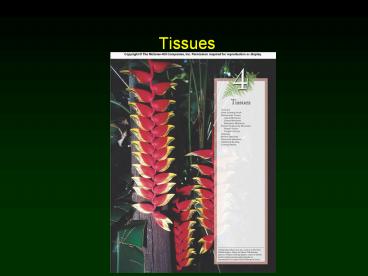Tissues - PowerPoint PPT Presentation
1 / 27
Title:
Tissues
Description:
Meristems - Permanent regions of active cell division. Apical Meristems - Found at the ... Aerenchyma - Parenchyma tissue with extensive connected air spaces. ... – PowerPoint PPT presentation
Number of Views:548
Avg rating:3.0/5.0
Title: Tissues
1
Tissues
- Chapter 4
2
Outline
- Meristematic Tissues
- Apical Meristems
- Lateral Meristems
- Intercalary Meristems
- Simple Tissues
- Complex Tissues
3
Meristematic Tissues
- Meristems - Permanent regions of active cell
division. - Apical Meristems - Found at the tips of roots and
shoots. - Increase in length as the apical meristems
produce new cells (primary growth). - Primary Meristems
- Protoderm
- Ground Meristem
- Procambium
4
Meristematic Tissues
- Lateral Meristems - Produce tissues that increase
the girth of roots and stems. - Secondary Growth
- Vascular Cambium - Produces secondary tissues
that function primarily in support and
conduction. - Thin cylindrical cells.
- Cork Cambium - Lies outside vascular cambium just
inside the outer bark.
5
Fig. 4.1
6
Meristematic Tissues
- Grasses and related plants do not have vascular
cambium or cork cambium, but do have apical
meristems in the vicinity of the nodes. - Intercalary meristems
- Develop at intervals along stems where they add
to stem length.
7
Tissues Produced By Meristems
- Simple Tissues
- Parenchyma - Composed of parenchyma cells. Tend
to have large vacuoles and many contain various
secretions. - Aerenchyma - Parenchyma tissue with extensive
connected air spaces. - Chlorenchyma - Parenchyma cells containing
chloroplasts.
8
Fig. 4.2
9
Simple Tissues
- Collenchyma - Contain living cytoplasm and may
live an extended time. - Provide flexible support for organs.
- Sclerenchyma - Cells with thick, tough, secondary
walls, normally impregnated with lignin. - Sclerids - Stone Cells
- Fibers - Contain Lumen
10
Fig. 4.3
11
Fig. 4.4
12
Fig. 4.5
13
Complex Tissues
- Complex tissues are made up of two or more cell
types. - Xylem - Chief conducting tissue for water and
minerals absorbed by the roots. - Vessels - Made of vessel elements.
- Long tubes open at each end.
- Tracheids - Tapered at the ends with pits that
allow water passage between cells. - Rays - Lateral conduction.
14
Fig. 4.6
15
Fig. 4.7
16
Fig. 4.8
17
Fig. 4.9
18
Complex Tissues
- Phloem - Conducts dissolved food materials
produced by photosynthesis throughout the plant. - Sieve Tube Members - Large, cylindrical
- Sieve Plates - Porous region
- Companion Cells - Narrow, tapered
19
(No Transcript)
20
Complex Tissues
- Epidermis - Outermost layer of cells.
- One cell thick
- Most secrete fatty substance, cutin, on the
surface of the outer walls. - Forms cuticle.
- Root epidermal cells produce root hairs.
- Leaves have stomata bordered by pairs of guard
cells.
21
(No Transcript)
22
Fig. 4.12
23
Fig. 4.13
24
Complex Tissues
- Periderm - Constitutes outer bark.
- Primarily composed of cork cells.
- Cytoplasm of corks cells secretes suberin into
the walls. - Some parts of cork cambium form loosely arranged
pockets of parenchyma cells that protrude through
the surface of the periderm. - Lenticels
25
(No Transcript)
26
Complex Tissues
- Secretory Cells and Tissue
- Secretory cells may function individually or as
part of a secretory tissue. - Flower nectar
- Citrus oils
- Glandular hair mucilage
- Latex
27
Review
- Meristematic Tissues
- Apical Meristems
- Lateral Meristems
- Intercalary Meristems
- Simple Tissues
- Complex Tissues

